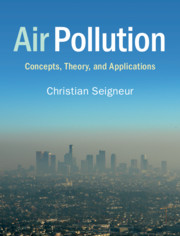Book contents
- Air Pollution
- Air Pollution
- Copyright page
- Contents
- Preface
- Main Notations
- 1 Brief History of Air Pollution
- 2 Emissions of Air Pollutants and Emission Control Technologies
- 3 Meteorology: General Circulation
- 4 Air Pollution Meteorology
- 5 Atmospheric Radiative Transfer and Visibility
- 6 Atmospheric Dispersion
- 7 The Stratospheric Ozone Layer
- 8 Gaseous Pollutants
- 9 Atmospheric Particles
- 10 Clouds and Acid Rain
- 11 Transfer of Pollutants between the Atmosphere and Surfaces
- 12 Health Effects
- 13 Environmental Impacts
- 14 Climate Change and Air Pollution
- 15 Regulations and Public Policies
- Index
- References
12 - Health Effects
Published online by Cambridge University Press: 19 June 2019
- Air Pollution
- Air Pollution
- Copyright page
- Contents
- Preface
- Main Notations
- 1 Brief History of Air Pollution
- 2 Emissions of Air Pollutants and Emission Control Technologies
- 3 Meteorology: General Circulation
- 4 Air Pollution Meteorology
- 5 Atmospheric Radiative Transfer and Visibility
- 6 Atmospheric Dispersion
- 7 The Stratospheric Ozone Layer
- 8 Gaseous Pollutants
- 9 Atmospheric Particles
- 10 Clouds and Acid Rain
- 11 Transfer of Pollutants between the Atmosphere and Surfaces
- 12 Health Effects
- 13 Environmental Impacts
- 14 Climate Change and Air Pollution
- 15 Regulations and Public Policies
- Index
- References
Summary
The health effects of air pollution are difficult to characterize because of the large number of air pollutants present in the atmosphere and the relatively small contribution of their health effects compared to all other causes. In addition, air pollution does not affect all people in the same way. Some persons are more sensitive than others: for example, those suffering from asthma, chronic obstructive pulmonary disease (COPD) or cardiovascular problems, the elderly, and children. Also, some individuals are more vulnerable than others: those include, for example, workers and residents who tend to be in locations where air pollution exposure is greater than average. This chapter describes first how adverse health effects of air pollution can be identified and quantified using toxicological and epidemiological studies. Next, methods commonly used to conduct health risk assessments related to air pollution are presented. The use of such information to set up air quality regulations is presented in Chapter 15.
- Type
- Chapter
- Information
- Air PollutionConcepts, Theory, and Applications, pp. 286 - 303Publisher: Cambridge University PressPrint publication year: 2019



